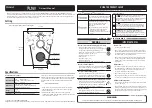
Circuit Description— Type 1L3Q
If the reference point is changed to the common side of
the input windings of T330 and T331 (shown as a phantom
ground on the simplified drawing) the impedance looking
into the output terminals of the transformers is balanced,
and the drive signal to the amplifiers is a balanced push-
pull signal.
Transformers T343 and T354 in the collector circuit of
Q340 and Q 350 provide a 4:1 impedance transformation
from the collectors of the transistors to the output trans
former T347.
Transformer T347 provides the conversion from a push-
pull to single-ended signal output. Push-pull amplification,
plus filtering through the low pass filter circuit of L358-
C358 and -L348-C348, reduces the harmonic content of the
swept frequency output signal.
Diode D334 in the base voltage divider circuit provides
the temperature compensation for the transistors (Q340-
Q350).
The single-ended output is coupled through a 2:1 imped
ance transformer T363, to the mixer in the wide band IF.
It is also applied through two feedback loops to frequency
and amplitude control circuits.
Frequency Discriminator.
Two frequency discriminators
for each position of the DISPERSION RANGE selector SW230
provide an output voltage signal to the frequency discrimina
tor comparator Q260. The output voltage from the com
parator is a ramp voltage that is proportional to the sweep
oscillator frequency applied through D240 to one side of
the comparator (Q230-Q240).
The M H z /C M discriminator consists of two matched di
odes, D373 and D376, at the input end of two transmission
lines. The transmission lines are % wavelength at the cen
ter frequency (275 MHz). One line is open ended and ap
pears capacitive, the other line is shorted and appears
inductive, at the center frequency. As the input frequency
to the discriminator increases, the transmission line input
impedance approaches the characteristics of a V4 wave
length line. The shorted transmission line input impedance
increases; the open ended line input impedance decreases.
This produces a proportionate change to the outpui sig
nal voltage from the diodes. Signal voltage outpui from
diode D376 becomes more negative, and the signal volt
age output from D373 becomes less negative. This provides
a differential signal drive to the comparator Q260 which is
converted to a single ended output signal for the sweep
compartor (Q230-Q240). The IF CENTER FREQ and the FINE
(IF CENTER FREQ) controls, R270 and R274, shift the cur
rent distribution through the comparator Q260 to change the
average DC level of the output signal to Q240. This allows
the IF center frequency to be shifted without affecting the
dispersion calibration or dispersion linearity of the display.
The amplitude of the ramp signal from Q240 to the swept
oscillator is a function of the DISPERSION RANGE switch
SW230 and the DISPERSION selector SW220 setting. This
voltage amplitude determines the frequency deviation of the
sweep oscillator, or the dispersion of the display.
The discriminator for the kH z/C M position of the DIS
PERSION RANGE switch consists of two tuned circuits and
detectors that operate in a manner similar to the tuned
transmission lines for the M H z /C M discriminator. The par-
3 -6
a'iei circuit L384-C384 is tuned slightly below the center
frequency,
and
the
circuit L385-C385 is tuned above the
center
of the
swept
oscillator frequency. The voltage out
put
versus
frequency
of the detectors is shown in Fig. 3-6A
and
3 6B.
W hen the
detector output is applied to the com
pa rator,
.a
v o lta g e
-versus frequency curve similar to Fig.
3 6C becomes
the resultant
output of the comparator Q260.
The circuit
operates
over the linear portion of the response
curve.
The kH z/C M Cal adjustment R368 changes the im
pedance across D365
which sets the slope of the kH z/C M
discrim inator output to
approximately twenty times the slope
of the
M H z /C M
discrim inator.
Fig. 3-6.
Frequ
ency vs
Voltage curves for kHz/CM discriminator
circuit. (A ) O utp^r from D 383;
(B) output from D386; (C) output
from discrim inator com parator Q 26 0.
Diodes D380 and D387 isolate the narrow band dis
criminator tuned circuit when the Type 1L30 is operating in
the M H z /C M dispersion range. They prevent parasitic os
cillation due to circuit coupling between the wide band
and narrow band discriminators. The diodes are forward
Diosed when the DISPERSION RANGE switch is in the M H z /
CM position, and load the k H z /C M tuned circuit. The di
odes are- back-biased and disconnected from the narrow dis
persion discriminator circuit when the DISPERSION RANGE
switch is in the kH z/C M 'position.
. .
.
Arnplnucie C om parator. Uniform sensitivity and linear
ity over the dispersion range is maintained by controlling
or regulating the oscillator output amplitude. This is accom-
©
Summary of Contents for 1L30
Page 48: ...si L i y n Maintenance Type 1L30 Fig 4 15 Honeycomb assembly drcui a n d component layout 4 n ...
Page 59: ...Fig 6 1 A Test equipment required for calibration ...
Page 60: ... Calibration Type 1130 ...
Page 120: ...T Y P E I L 3 0 S P E C T R U M A N A L Y Z E R ib i IF SYSTEM BLOCK DIAGRAM 9 1 9 2 ...
Page 127: ......
















































